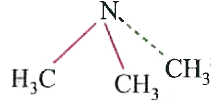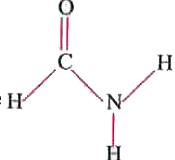The hybridisation of Nitrogen in Nitrate ion is
sp
sp2
sp3
sp3d
The correct Answer is:B
To determine the hybridization of nitrogen in the nitrate ion (NO3^-), we can follow these steps:
Step 1: Identify the Lewis Structure of the Nitrate Ion
- The nitrate ion consists of one nitrogen atom and three oxygen atoms.
- In the Lewis structure, nitrogen is at the center, bonded to three oxygen atoms. One of these bonds is a double bond while the other two are single bonds.
- The overall charge of the ion is -1, which is distributed among the oxygen atoms.
Step 2: Count the Number of Sigma Bonds
- In the nitrate ion, there are:
- One double bond (N=O), which contributes one sigma bond and one pi bond.
- Two single bonds (N-O), each contributing one sigma bond.
- Therefore, the total number of sigma bonds is:
- 1 (from the double bond) + 2 (from the single bonds) = 3 sigma bonds.
Step 3: Determine the Hybridization
- The number of hybrid orbitals formed corresponds to the number of sigma bonds.
- Since there are 3 sigma bonds, nitrogen must have 3 hybrid orbitals.
- The hybridization that corresponds to 3 hybrid orbitals is sp² hybridization (1 s orbital and 2 p orbitals mix to form 3 sp² hybrid orbitals).
Step 4: Conclusion
- Therefore, the hybridization of nitrogen in the nitrate ion (NO3^-) is sp².
Final Answer:
The hybridization of nitrogen in the nitrate ion (NO3^-) is sp².
---
- The nitrate ion consists of one nitrogen atom and three oxygen atoms.
- In the Lewis structure, nitrogen is at the center, bonded to three oxygen atoms. One of these bonds is a double bond while the other two are single bonds.
- The overall charge of the ion is -1, which is distributed among the oxygen atoms.
- In the nitrate ion, there are:
- One double bond (N=O), which contributes one sigma bond and one pi bond.
- Two single bonds (N-O), each contributing one sigma bond.
- Therefore, the total number of sigma bonds is:
- 1 (from the double bond) + 2 (from the single bonds) = 3 sigma bonds.
- The number of hybrid orbitals formed corresponds to the number of sigma bonds.
- Since there are 3 sigma bonds, nitrogen must have 3 hybrid orbitals.
- The hybridization that corresponds to 3 hybrid orbitals is sp² hybridization (1 s orbital and 2 p orbitals mix to form 3 sp² hybrid orbitals).
- Therefore, the hybridization of nitrogen in the nitrate ion (NO3^-) is sp².
The hybridization of nitrogen in the nitrate ion (NO3^-) is sp².
Topper's Solved these Questions
- BOOK - NARAYNACHAPTER - CHEMICAL BONDING AND MOLECULAR STRUCTUREEXERCISE - EXERCISE- I (C.W.) (DATIVE BOND)6videos
CHEMICAL BONDING AND MOLECULAR STRUCTURE
- BOOK - NARAYNACHAPTER - CHEMICAL BONDING AND MOLECULAR STRUCTUREEXERCISE - EXERCISE- I (C.W.) (MOLECULAR ORBITAL THEORY)10videos
CHEMICAL BONDING AND MOLECULAR STRUCTURE
- BOOK - NARAYNACHAPTER - CHEMICAL BONDING AND MOLECULAR STRUCTUREEXERCISE - EXERCISE- I (C.W.) (VSEPR THEORY)6videos
CHEMICAL BONDING AND MOLECULAR STRUCTURE
- BOOK - NARAYNACHAPTER - CARBONYL COMPOUNDSEXERCISE - LEVEL -VI99videos
CARBONYL COMPOUNDS
- BOOK - NARAYNACHAPTER - CHEMICAL EQUILIBRIUMEXERCISE - Exercise -IV33videos
CHEMICAL EQUILIBRIUM
Similar Questions
Knowledge Check
- Question 1 - Select One
The hybridisation of nitrogen in R2NH is :
Asp3Bsp2CspDdsp2 - Question 2 - Select One
The hybridisation of nitrogen in
 (pyrrole) is: Asp3Bsp2CspDCan't be predicted
(pyrrole) is: Asp3Bsp2CspDCan't be predicted - Question 3 - Select One
Geometry of ammonia molcule and the hybridisation of nitrogen involved in it are
Asp3-hybridisation and tetrahedral geometryBsp3-hybridisation and distorted tetrahedral geometryCsp2- hybridisation and triangular geometryDNone of the above
Trimethylamine is a pyramidal molecule
 and formamide is a planar molecule
and formamide is a planar molecule  the hybridisation of Nitrogen in both is View Solution
the hybridisation of Nitrogen in both is View SolutionIn [Ni(H2O)6]2+ , the hybridisation of central metal ion is :
View SolutionHeterolytic bond fission in C2H6 gives carbonium and carbonion ions . The hybridisation of carbon atoms in these ions is :
View SolutionThe oxidation number of nitrogen in nitride ion is
View SolutionWhich of the following complexes are not correctly matched with the hybridisation of their central metal ions ?
View Solution

